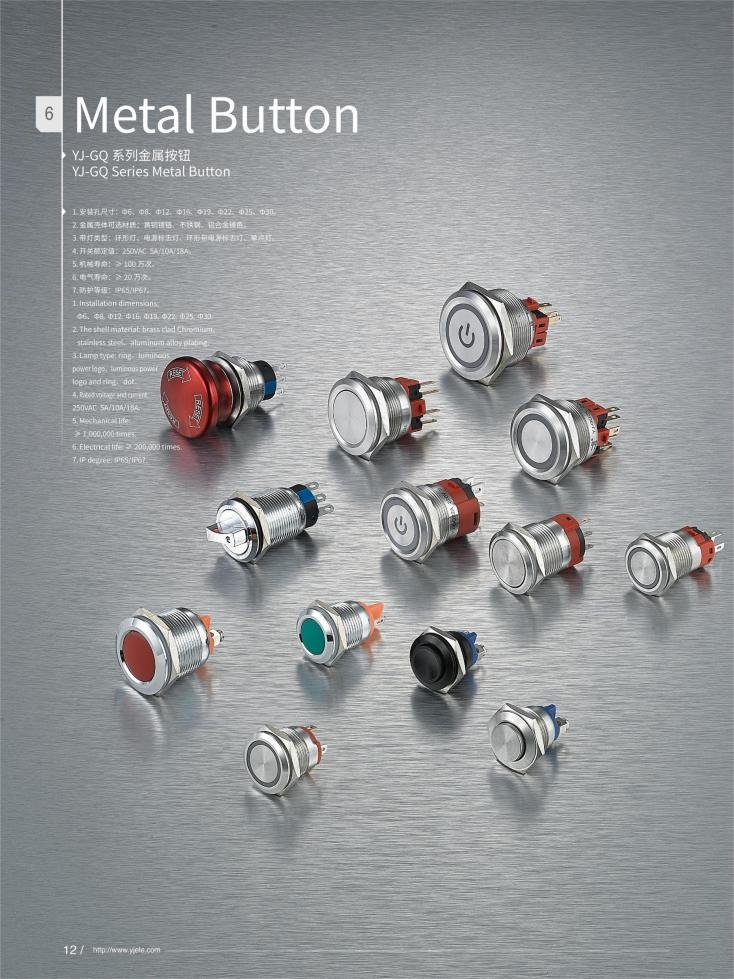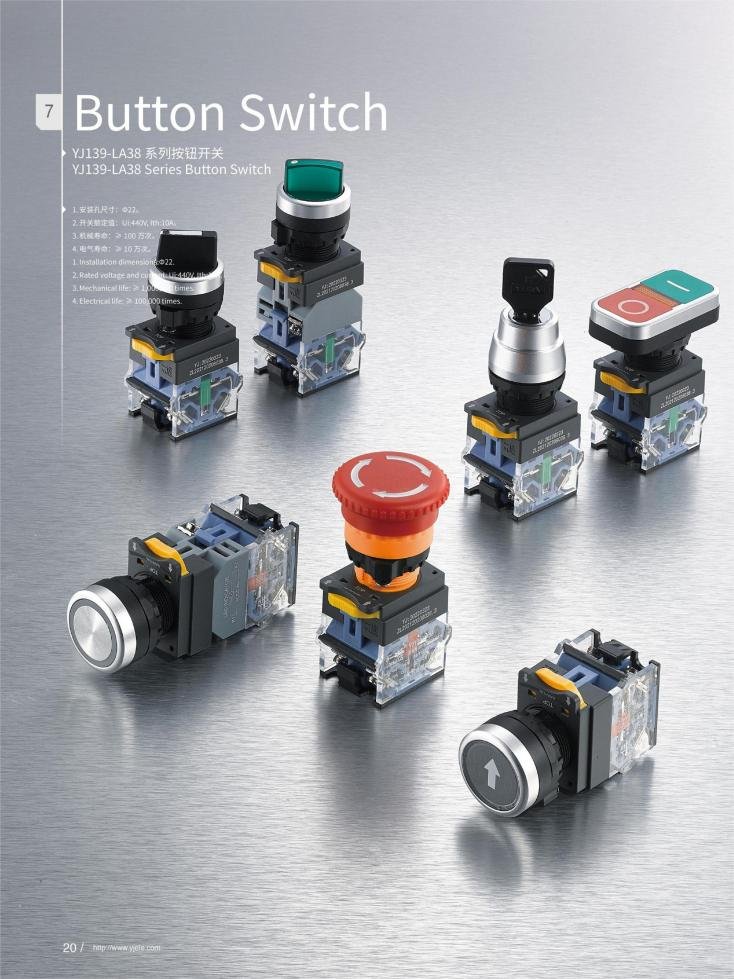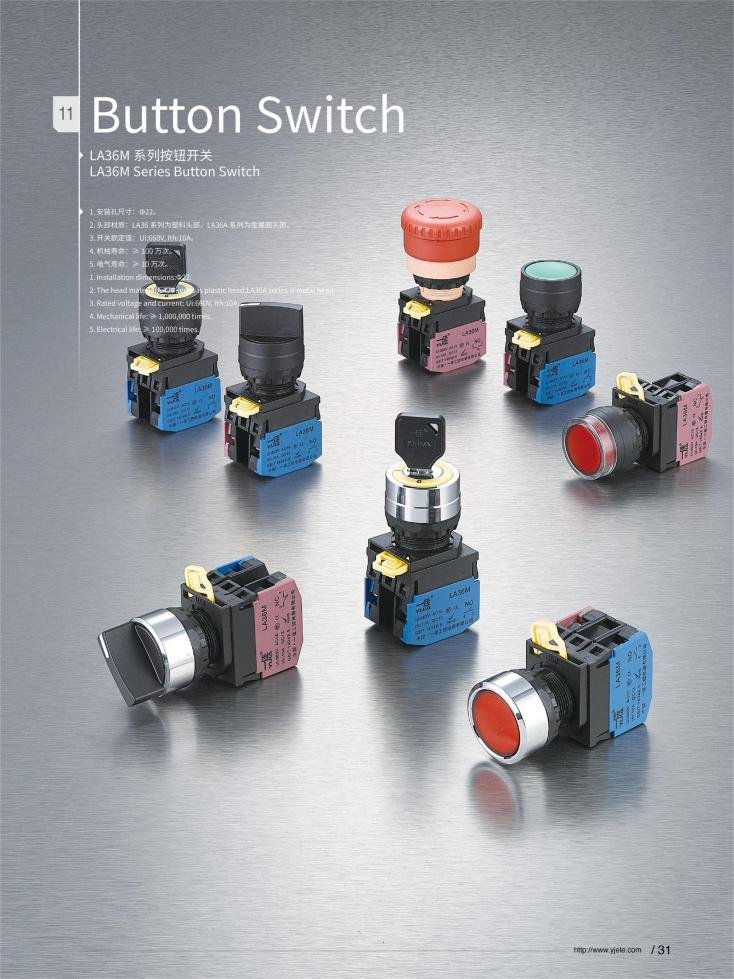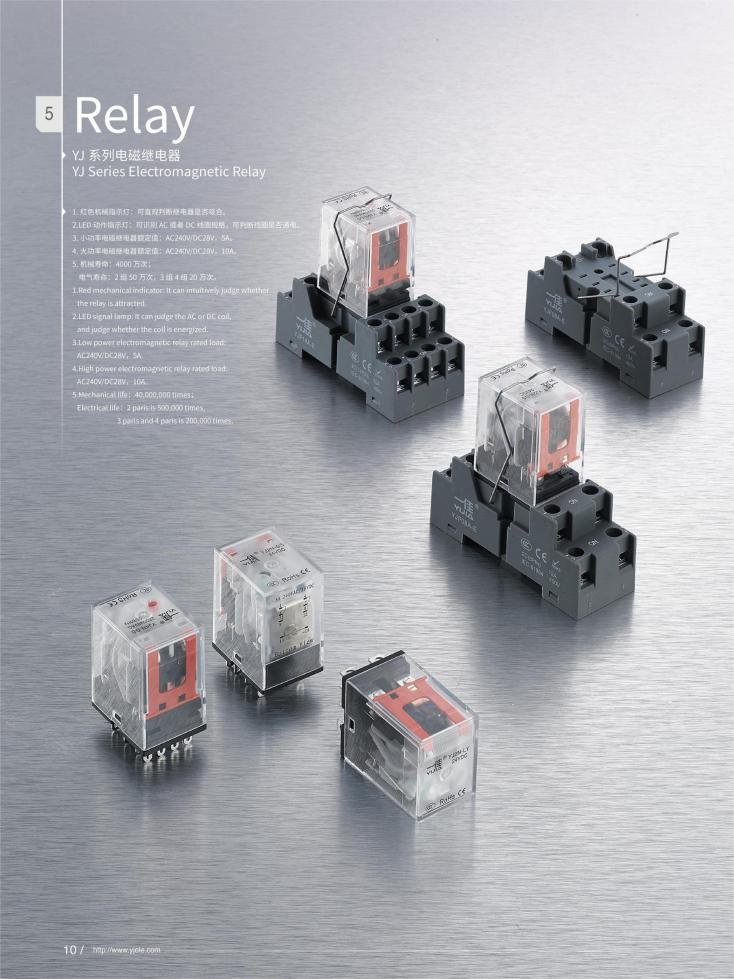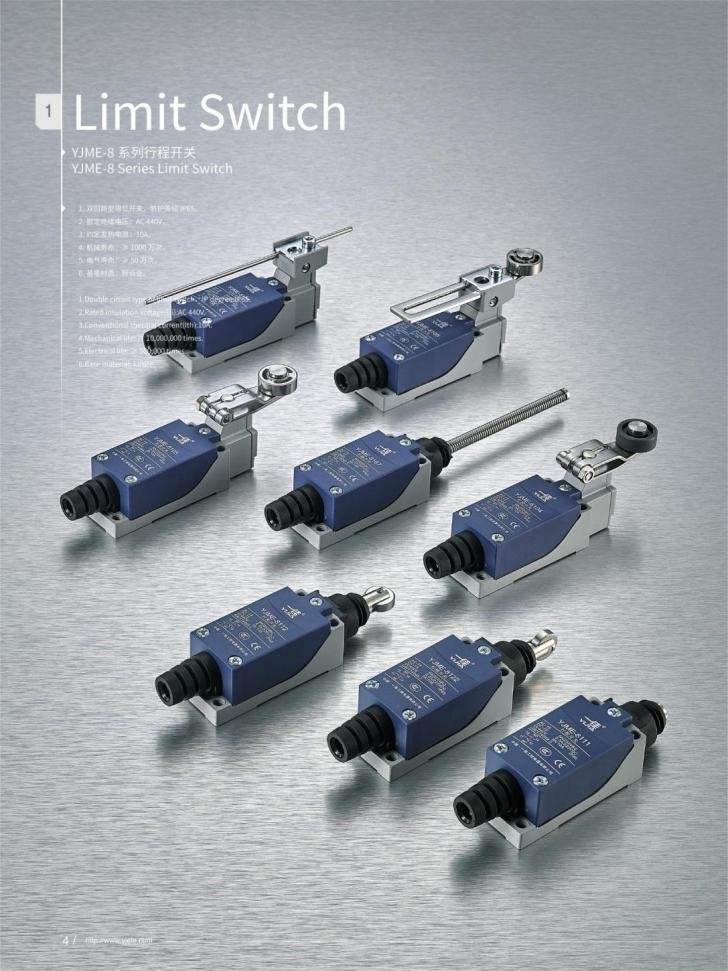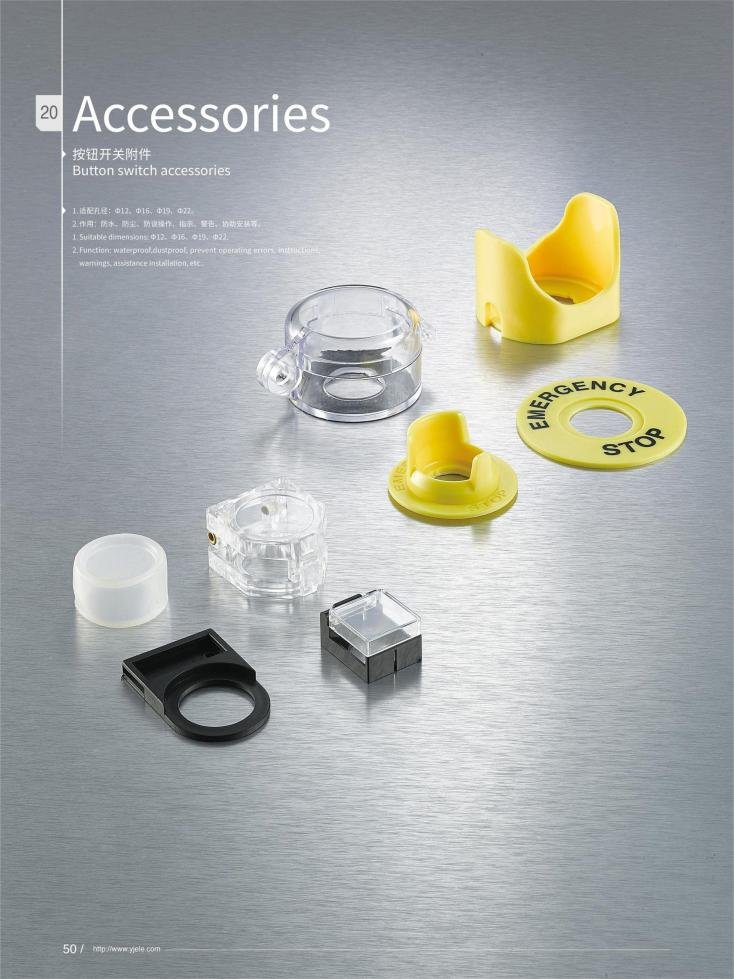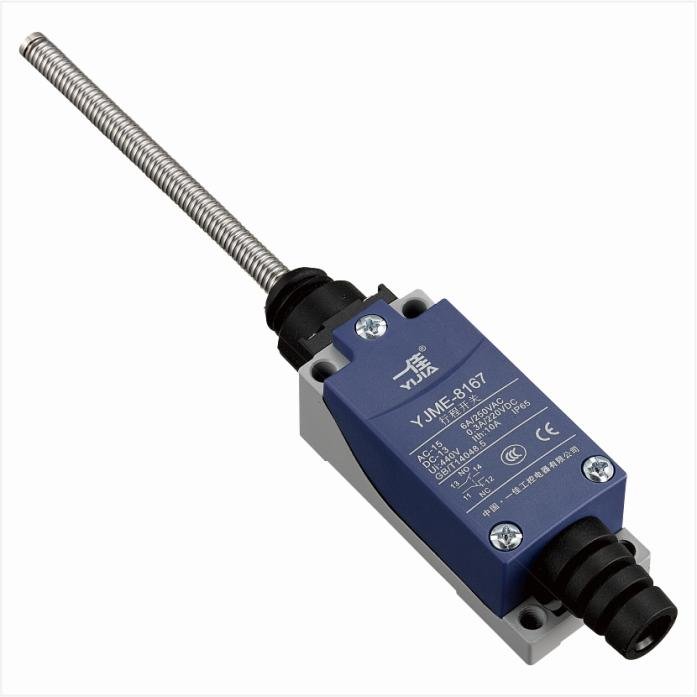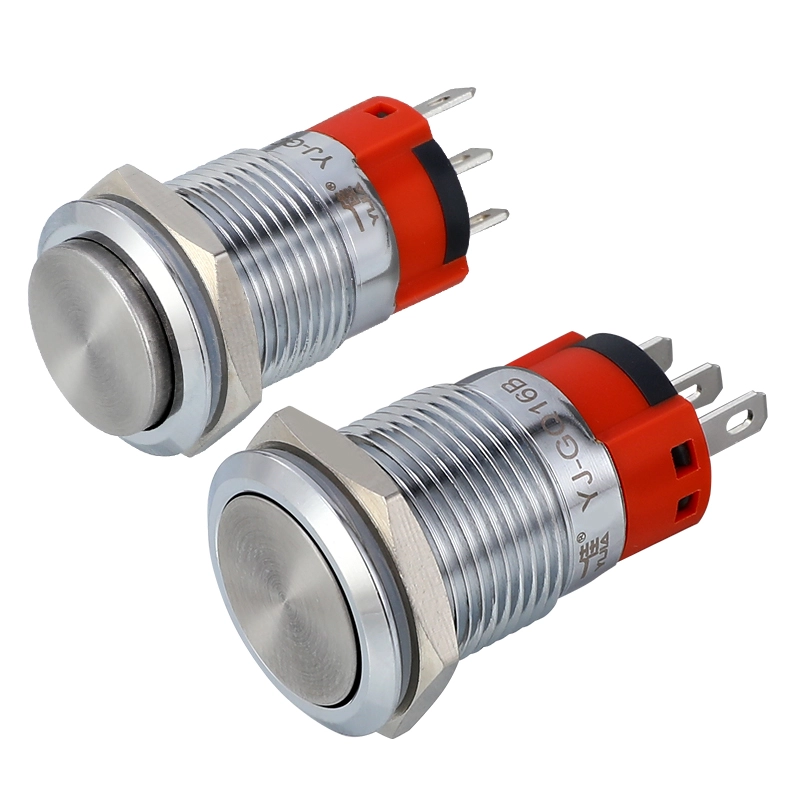Basic knowledge of micro limit switches
What is a miniature limit switch?
A miniature limit switch is a small electrical switch typically used to detect the position or end of mechanical movement. It uses mechanical contact or non-contact mode to trigger the switch action when it detects that the object reaches the preset position, thereby controlling the operating status of the equipment. Due to their small size, sensitive operation and high reliability, micro limit switches are widely used in household appliances, automation equipment, industrial control systems and other fields.
Common types of micro limit switches
Micro limit switches can be divided into the following common types according to their structure and functions:
1. Roller type micro limit switch
The main feature of the roller type micro limit switch is that it has a small roller. When a mechanically moving object contacts the roller and pushes it, the roller will rotate, thereby triggering the switch. Roller type switches are often used where linear or rotary motion needs to be detected, such as robotic arms and conveyor belts on automated production lines. The switch features low friction and high sensitivity, allowing it to respond accurately to light contact.
2. Button type micro limit switch
Push-button type micro limit switches trigger the internal switching element by directly pressing the button. It has a simple structure and is easy to install. It is usually used in application scenarios that require direct contact, such as buttons of household appliances and automatic door control devices. The push-button switch has a small triggering force and is easy to operate, making it suitable for various simple mechanical or electronic equipment.
3. Lever type micro limit switch
Lever-type micro limit switches have a lever that triggers the switch when pushed by a mechanically moving object. Lever-type switches are suitable for situations that require a large range of motion and flexible triggering, such as industrial equipment, automation devices, etc. The levers can be designed in different lengths and shapes according to requirements to adapt to various application environments. Its advantages are flexible movement, adjustable trigger points, and strong adaptability.
4. Blade type micro limit switch
Blade-type micro limit switches have a thin blade that triggers the switch when bent by mechanical force. This kind of switch is often used to detect slight movements or small displacements, and is suitable for applications with high sensitivity requirements, such as micro mechanical devices, electronic instruments, etc. The blade type switch has the characteristics of high sensitivity and low triggering force, and can detect very subtle displacement changes.
5. Rotary micro limit switch
Rotary micro limit switches trigger internal switching components through rotational movement and are often used for limit detection of rotating machinery or devices. For example, in some automated mechanical equipment, when the rotating part reaches a certain position, a switch is triggered to control the stop or reversal of the equipment. Rotary switches have high precision and reliability and are suitable for applications requiring precise position control.
6. Micro-action micro limit switch
The inching micro limit switch is a highly sensitive small switch that is usually used in applications that require high precision and fast response, such as precision instruments, electronic equipment, computer mice, etc. Micro switches are characterized by very small triggering force, fast response speed, and the ability to respond in a very short time. Its internal structure is precise and can withstand repeated operations while maintaining reliability.
Features, advantages and disadvantages
Features
- Small and compact: Micro limit switches are small in size and light in weight, making them suitable for installation in equipment and systems with limited space without affecting the layout and functionality of other components.
- High sensitivity: Due to its precise design, the micro limit switch is able to detect tiny mechanical displacements with high sensitivity and accuracy.
- Diversified triggering methods: Micro limit switches have a variety of triggering methods, such as rollers, buttons, levers, blades, and rotations, which are suitable for different application scenarios and needs.
- High reliability: These switches usually use high-quality materials and precision manufacturing processes to withstand frequent operations and harsh working environments, with long service life and stable performance.
- Fast response: The micro limit switch has a short action time and can respond in a very short time, which is very suitable for control systems that require fast response.
Advantage
- Easy installation: Due to its small size and light weight, micro limit switches can be easily installed in various equipment and systems without taking up much space.
- Versatility: Different types of miniature limit switches can meet various application needs, from simple mechanical displacement detection to complex automation control, you can find the right model.
- High precision: Micro limit switches can accurately detect the position of mechanical movement, ensuring the accuracy and reliability of the control system.
- Economical and efficient: Micro limit switches have low manufacturing costs and stable performance, which can reduce the cost of the overall system while ensuring quality.
- Strong durability: High-quality miniature limit switches can withstand frequent mechanical operations and environmental changes, making them suitable for long-term use.
Shortcoming
- Trigger Force Limitation: Some types of miniature limit switches require smaller trigger forces, which may not be suitable in certain high-force or high-vibration applications.
- Environmental limitations: Miniature limit switches may be affected by extreme temperatures, high humidity, or highly corrosive environments, requiring the selection of models with special materials or designs.
- Electrical characteristic limitations: Due to their small size, micro limit switches have limited current and voltage handling capabilities and are not suitable for high-power electrical equipment and require additional circuit protection measures.
- Mechanical wear: In high-frequency mechanical operations, the mechanical part of the micro limit switch may wear out, affecting its service life and requiring regular maintenance or replacement.
How micro limit switches work
The working principle of the micro limit switch is based on mechanical triggering and electrical signal conversion. The circuit inside the switch is triggered by mechanical movement, thereby opening or closing the circuit. The specific working principle is as follows:
working principle
- Mechanical triggering: When external mechanical moving parts (such as push rods, rollers, levers, etc.) reach the preset position, they will contact the triggering part of the micro limit switch. Depending on the type of switch, the triggering component may be a button, wheel, blade, or lever.
- Contact action: After the trigger component is acted upon by an external force, it pushes the internal spring or other mechanical components, causing the contacts inside the switch to move. Movement of the contacts changes the state of the switching circuit, converting the circuit from a closed state to an open state, or from an open state to a closed state.
- Electrical signal output: After the contact moves, the circuit status of the micro limit switch changes and the corresponding electrical signal is output. These electrical signals can be used to control other electrical equipment or systems, such as stopping motors, starting alarms, switching control loops, etc.
Example description
Taking the roller type micro limit switch as an example, when the detected object moves to a specific position, the object will contact and push the roller. The rotation of the roller drives the internal mechanical structure to move, causing the internal contacts to move and change the circuit state. At this time, the switch outputs an electrical signal indicating that the object has reached the preset position.
Contact type
There are many types of contacts for micro limit switches, common ones include:
- Normally open contact (NO): The circuit is open under normal conditions and closed when triggered.
- Normally closed contact (NC): The circuit is closed under normal conditions and opened when triggered.
- Change-over contact (COM): Normally used in conjunction with normally open and normally closed contacts to switch between the two.
Application of Micro Limit Switch
Micro limit switches are widely used in various scenarios requiring position detection and control due to their compactness, sensitivity and reliability. Here are some common application scenarios:
1. Industrial automation
In automated production lines, micro limit switches are used to detect the position and motion status of mechanical components. For example:
- Robotic arm: Detect the end position of the robotic arm to ensure precise positioning and safe operation.
- Conveyor belt: Monitor the position of objects on the conveyor belt and control the start and stop of the conveyor belt.
- Processing equipment: In CNC machine tools, punch presses and other equipment, limit switches are used to detect the position of the tool or workpiece to prevent overtravel damage.
2. Household appliances
Micro limit switches play an important role in various household appliances to ensure the normal operation and safety of the equipment. For example:
- Washing machine: Detect the opening and closing status of the washing machine door to ensure that the program can only be started when the door is closed.
- Microwave oven: Make sure the microwave door is closed to prevent it from starting when the door is not fully closed.
- Refrigerator: Detect the status of the refrigerator door, control the light switch and adjust the temperature of the refrigerator compartment.
3. Security equipment
In security equipment, miniature limit switches are used to monitor and control the status of safety devices. For example:
- Elevator: Detect the opening and closing status of the elevator door to ensure that the elevator can start running only after the door is closed.
- Automatic door: Monitor the opening and closing of the automatic door to prevent misoperation when the door is not fully closed.
- Anti-theft alarm system: Install limit switches on anti-theft doors and windows to trigger an alarm when the doors and windows are opened.
4. Medical equipment
- In medical equipment, miniature limit switches are used for precise control and detection. For example:
- Operating table: Detect the height and angle of the operating table to ensure precise positioning during surgery.
- Laboratory equipment: In centrifuges, thermostats and other equipment, monitor the opening and closing status of the lid to ensure safe operation.
5. Automobile industry
Micro limit switches are also widely used in automobiles to detect and control the status of various automobile components. For example:
- Car door: Detect the opening and closing status of the car door, and control the interior lighting and alarm system.
- Seat position: Detect the adjustment position of the seat to ensure the comfort and safety of the driver and passengers.
- Trunk: Monitor the opening and closing status of the trunk lid to prevent the trunk from being accidentally opened while driving.
6. Office equipment
In office equipment such as printers and copiers, miniature limit switches are used to detect the status of paper and covers. For example:
- Printer: Detect the paper feeding and output status to ensure the smooth printing process.
- Copier: Monitor the opening and closing of the cover to ensure the normal progress of the copying process.
7. Electronic equipment
In some precision electronic equipment, miniature limit switches are used to detect and control the status of internal components. For example:
- Computer mouse: The internal micro switch is used to detect the pressed and released state of the keys and provide user input.
- Keyboard: In mechanical keyboards, micro switches are used to detect the movement of each key to improve input accuracy and response speed.
How to choose a miniature limit switch
There are several factors to consider when purchasing a miniature limit switch to ensure that the switch you select will meet your specific application needs and provide reliability and durability. The following are the main aspects that should be paid attention to when purchasing a miniature limit switch:
1. Application environment
- Temperature and humidity: Determine the working environment temperature and humidity range of the switch. Choose a switch that will function properly under expected environmental conditions.
- Protection level: According to the requirements of the application environment, select a switch with the corresponding protection level. For example, in humid or dusty environments, you need to choose a switch with an IP protection rating.
2. Trigger method
- Roller type, button type, lever type, blade type, rotary type, etc.: Choose the appropriate triggering method according to the mechanical movement method of the specific application. For example, the roller type is suitable for linear or rotational motion detection, and the button type is suitable for direct press triggering, etc.
3. Contact type
- Normally open (NO): The circuit is open when not triggered and closed when triggered. Suitable for applications that do not require power supply under normal circumstances.
- Normally closed (NC): The circuit is closed when not triggered and disconnected when triggered. Suitable for applications that require power under normal circumstances.
- Changeover contact (COM): Able to switch between normally open and normally closed, suitable for applications requiring different control logic.
4. Electrical parameters
- Voltage and current ratings: Make sure the switch you choose can withstand the operating voltage and current in your application. Avoid choosing a switch with lower rated parameters than your actual needs to avoid premature damage.
- Contact resistance and insulation resistance: Choose a switch with low contact resistance and high insulation resistance to ensure the stability and reliability of electrical performance.
5. Mechanical parameters
- Operating force and stroke: Select the appropriate operating force and stroke range based on application requirements. Too much operating force may affect the performance of the equipment, and too small a stroke may not achieve the expected detection results.
- Lifespan: Understand the mechanical and electrical lifespan of the switch and choose a switch that can handle the expected number of uses.
6. Installation method
- Installation size and method: Determine whether the installation size and method of the switch meet the installation requirements of the equipment. Common installation methods include screw installation, welding installation, snap installation, etc.
- Wiring method: Choose the appropriate wiring method according to actual needs, such as welding wiring, screw wiring, plug-in wiring, etc.
7. Brand and quality
- Brand reputation: Choose a micro limit switch from a well-known brand, with guaranteed quality and complete after-sales service.
- Certifications and standards: Ensure that the selected switch complies with relevant industry standards and certifications, such as UL, CE, etc., to ensure the safety and reliability of the product.
8. Value for money
- Price and performance: On the premise of meeting all technical requirements, compare the prices of different brands and models and choose products with high cost performance. Avoid pursuing low prices while ignoring quality.
9. Special needs
- Anti-vibration and impact: If there are large vibrations and impacts in the application scenario, you need to choose a switch with anti-vibration and anti-impact capabilities.
- Anti-corrosion and anti-explosion: When working in corrosive or hazardous environments, choose switches that are anti-corrosion or anti-explosion.
10. Suppliers and after-sales service
- Supplier reliability: Choose suppliers with good reputation and stable supply to ensure the reliability of the product supply chain.
- After-sales service: Understand the supplier’s after-sales service policy to ensure that you can receive timely technical support and replacement services when product problems arise.

